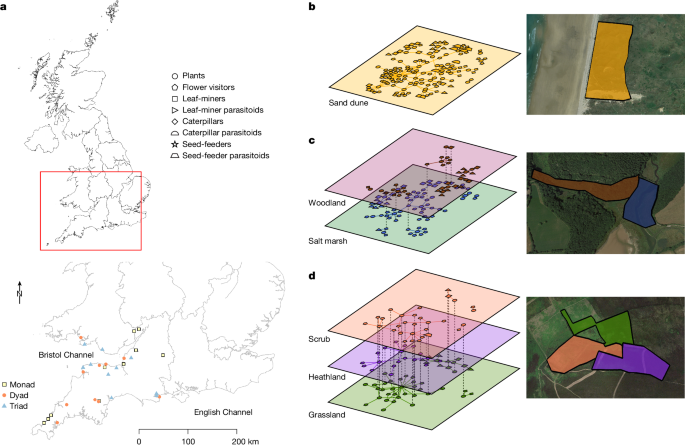Diverse and Stable Multi-Habitat Landscapes Enhance Ecosystem Function
Core Concepts
Multi-habitat landscapes support higher species and interaction evenness, more complementary species interactions, and more consistent robustness to species loss, leading to improved ecosystem function such as pollination success.
Abstract
The article investigates how the diversity and stability of multi-habitat landscapes affect ecosystem function at the landscape scale. The key findings are:
Multi-habitat landscapes (with 2-3 habitats) support higher species and interaction evenness, more complementary species interactions, and more consistent robustness to species loss compared to single-habitat landscapes.
These emergent network properties of multi-habitat landscapes drive improved ecosystem functions, such as pollination success, that are not explained by simply summing the component habitat webs.
The study combines multi-guild species interaction data (plant-pollinator and plant-herbivore-parasitoid communities) from landscapes with different habitat diversity, a field experiment, and modeling to demonstrate the mechanisms by which contiguous habitats can support landscape-scale ecosystem services.
The findings highlight the importance of considering landscape composition and community structure to understand and manage ecosystem function at larger scales, beyond the individual habitat level.
Multi-habitat landscapes are more diverse and stable with improved function - Nature
Stats
"Conservation, restoration and land management are increasingly implemented at landscape scales."
"We combine multi-guild species interaction data (plant–pollinator and three plant–herbivore–parasitoid communities, collected from landscapes with one, two or three habitats), a field experiment and a modelling approach to show that multi-habitat landscapes support higher species and interaction evenness, more complementary species interactions and more consistent robustness to species loss."
"These emergent network properties drive improved pollination success in landscapes with more habitats and are not explained by simply summing component habitat webs."
Quotes
"Linking landscape composition, through community structure, to ecosystem function, highlights mechanisms by which several contiguous habitats can support landscape-scale ecosystem services."
Key Insights Distilled From
by Talya D. Hac... at www.nature.com 08-21-2024
https://www.nature.com/articles/s41586-024-07825-y
Deeper Inquiries
How can the insights from this study be applied to guide landscape-scale conservation and restoration efforts?
The insights from this study can be instrumental in guiding landscape-scale conservation and restoration efforts by emphasizing the importance of maintaining and promoting multi-habitat landscapes. Conservation strategies can focus on preserving and restoring diverse habitats within a landscape to enhance species diversity, interaction evenness, and ecosystem function. By understanding the interconnectedness of habitats and the positive effects of multi-habitat landscapes on species interactions and ecosystem services, conservationists can prioritize efforts towards creating and maintaining such landscapes. Additionally, the study highlights the need for a holistic approach that considers the entire landscape rather than focusing on individual habitats in isolation.
What are the potential trade-offs or challenges in managing for multi-habitat landscapes compared to single-habitat approaches?
Managing for multi-habitat landscapes presents several potential trade-offs and challenges compared to single-habitat approaches. One challenge is the complexity of managing multiple habitats simultaneously, which requires a more comprehensive understanding of species interactions and ecosystem dynamics across different habitats. Additionally, coordinating conservation and restoration efforts across multiple habitats may require greater resources, collaboration among various stakeholders, and long-term planning. Trade-offs may arise in terms of prioritizing certain habitats over others, especially if resources are limited. Furthermore, managing multi-habitat landscapes may involve addressing conflicting interests or goals among different conservation objectives for each habitat type. Balancing these trade-offs and challenges requires careful planning, adaptive management strategies, and a thorough understanding of the ecological processes at play in diverse landscapes.
What other ecosystem functions, beyond pollination, might be influenced by the emergent properties of diverse multi-habitat landscapes?
In addition to pollination, the emergent properties of diverse multi-habitat landscapes can influence various other ecosystem functions. For example, nutrient cycling, soil health, and carbon sequestration can be positively impacted by the presence of diverse habitats within a landscape. The interconnectedness of habitats can enhance the resilience of ecosystems to environmental disturbances, leading to more stable and productive ecosystems. Biodiversity conservation, water purification, and pest control are other ecosystem functions that can benefit from the diverse species interactions and complementary relationships fostered in multi-habitat landscapes. By promoting diverse landscapes, conservation efforts can support a wide range of ecosystem functions that are essential for maintaining the health and sustainability of natural systems.
0
